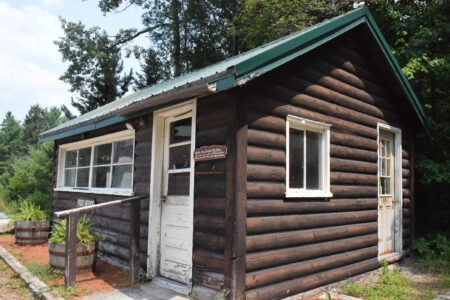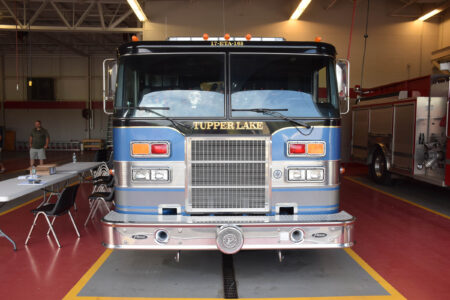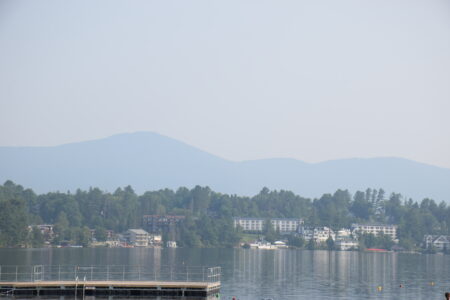Worrall settles in at Adirondack Mountain Club
New executive director reflects on nonprofit organization’s missionand past experience

LAKE PLACID — On a clear day, Cortney Worrall’s commute is about as picturesque as it gets. Driving down the Adirondack Loj Road, one is greeted with towering views of Algonquin, Wright, Colden, Marcy and numerous other High Peaks and surrounding mountains.
It’s a drive that Worrall said reminds her each day how lucky she is to serve as the head of a group whose mission is to ensure those pristine wilderness glimpses remain as such — the Adirondack Mountain Club (ADK). The nonprofit organization, which was founded more than a century ago in 1922, is one of the most consequential in the region.
In addition to owning and operating the Adirondak Loj — where Worrall’s office is located — High Peaks Information Center, Cascade Welcome Center and Johns Brook Lodge, along with surrounding lands and buildings, ADK plays a pivotal role in outdoor education and preservation. There are 25 local ADK chapters throughout New York and New Jersey. The organization hosts numerous school groups throughout the year, maintains an active summit stewardship program meant to educate hikers about the ecological significance and fragility of alpine vegetation (a partnership between ADK, the Adirondack Chapter of The Nature Conservency and the state Department of Environmental Conservation), engages in professional and volunteer trail building and maintenance, trailhead education, and — along with additional partner conservation groups — engages in legislative and policy advocacy in keeping with its mission.
The responsibilities loom large when leading an organization as sprawling as ADK. It’s something that Worrall, who was named its executive director in March and officially took the reins on May 1, has leaned on her decades of work in nonprofits, and time spent working in both government and the private sector prior to that. Worrall sat down with the Enterprise on Tuesday to discuss her background and what made her pursue a career in environmental nonprofits, her time at ADK so far and some goals she has for the organization going forward.
–
Background
–
Worrall comes from a family of outdoorspeople. On her mother’s side, she said there was a devotion to environmental conservation. Her father’s side has been involved in hunting, fishing and forestry for generations. Between that, she has ample experience to get outside, enjoy nature and realize the importance of conserving it.
“As a kid, I was always drawn to nature,” she said.
Worrall attended Mount Holyoke College in the late ’80s. At that time, she said environmental studies was not a common area of study, with physics, chemistry, biology and the other “hard sciences” being the predominant science degree tracks.
“I realized midway through that I was very unhappy with a straight science degree,” she said.
Fortunately for Worrall, her college offered more flexibility than most in its fields of study. She was allowed to craft her own major, taking courses offered through multiple departments to graduate with a bachelor’s degree in environmental policy.
“That was really great because it was, at the time, a fairly unique major,” she said. “And I was able to, right out of college, get into a job.”
That happened to be in environmental consulting, where she worked to ensure that new stormwater management rules in the early 1990s, borne out of the Clean Air Act, were being properly implemented at railroad and trucking facilities. Her consulting turned to watershed planning, and she subsequently earned a master’s degree in public administration from Columbia University.
She has worked in the nonprofit space, mostly in executive leadership roles, for about the last 20 years, most recently serving as the President and CEO of the Waterfront Alliance, a New York City-based organization whose mission is to “preserve the working waterfront; expand waterborne transportation; improve access to the waterways for recreation and education; and safeguard our coastal city against the threats posed by climate change and sea level rise,” according to its website.
Worrall said her work there centered around beefing up the Waterfront Alliance’s organization to take it from a fledgling grassroots organization to a major policy player in shaping legislative initiatives to create more resilient waterfront spaces along the New York and New Jersey coastlines.
“That work included a lot of grassroots — directly working with communities that were facing the impacts from climate change and facing impacts from the industrialization and the industrial legacy of the New York and New Jersey region, which is so true for so many parts of the country,” she said. “Connecting that grassroots community work to major policy change was one of the most exciting things that we worked on.”
Worrall said it’s not an easy time for environmental nonprofits currently, noting that in addition to staring down the loss of numerous federal resources and a shift away from conservation-oriented policy, organizations around the nation are having a difficult time connecting concerned people to actions that will actually make a difference. That doesn’t diminish their importance, she said, but rather makes it all the more necessary.
“It’s also at the core of what is needed for the world and for the country and for incredible places — sensitive, protected places like the Adirondacks. It just speaks to my heart in every way,” she said. “It’s been fulfilling.”
–
Leading ADK
–
Worrall said part of the reason she was drawn to ADK is that, currently and historically, the organization has been effective at not only building a community of staff, volunteers and members who are concerned about protecting the environment, but turning that concern into tangible action.
“There’s so much that ADK is doing to connect people to nature,” she said. “To help people be smart, sensitive stewards of such an important place where that direct interaction between humans and nature is just the key component — all around, but especially here.”
Worrall was also drawn to the ADK for the region’s natural beauty and ample opportunities to recreate outdoors. She spent seven years working close to national parks, and said the move out of the New York City to the Adirondacks was a natural shift as a result.
“Large landscape conservation is just absolutely my love,” she said. “And with ADK’s connection to the grassroots, to people, to the changes that have to happen at the individual level and all the way up to policy and advocacy changes — and how those two inform each other — is just some of the most exciting work that there can be.”
At the individual level, Worrall said ADK’s 25 local chapters put on a number of outings and ADK staff run outdoor skills training sessions to get people out and enjoying nature with the skillset to do so safely and responsibly. Sparking an interest in getting out and enjoying nature, Worrall said, is often the first step to protecting it.
“If people don’t enjoy it, they won’t care about it and they won’t do all the things that we need to continue preserving this amazing place,” she said.
Worrall noted that the work with local schools was particularly important. Worrall said ADK is focused on working with educators to take those experiences not as a one-off, but to work them into the broader science and related curriculum throughout the year. She said people can sometimes take for granted that just because kids live close to the Adirondacks, they will have received an opportunity to experience nature.
“We find that the majority of students that we work with actually have never been on a hike, even though they come from local schools,” she said. “Unfortunately, I found that was the case in other parts of work that I’ve done throughout the state and Northeast, so it’s really so important that we are connecting younger people to nature.”
In her first month, Worrall said the most challenging aspect of the job was in the logistics — specifically adjusting to ADK’s software and computer programs. She said it’s a different internal system than her previous job, and has had to learn a lot from the ground up. In so doing, Worrall said she has leveraged her fresh perspective to find ways where the technology could be optimized and made more efficient.
“It’s about just making sure that we’re working efficiently (and) that the internal operations are top notch,” she said.
Worrall said another challenge has simply been getting herself up to speed with the breadth of work that ADK does has been a lot to digest, but learning the ins and outs of it, even as it takes a lot of time, are crucial. These include ADK’s visitor and membership engagement strategies, as well as facilities operations and management.
She was particularly excited about the various ideas and plans that are underway for ADK to get more use out of its Cascade Welcome Center.
“The story has yet to be written in terms of how we’re going to fully take advantage of that amazing location,” she said. “We’re going to continue our visioning exercise and get ideas from staff and outside partners on what it could look like. First of all, it’s an education center. It’s a place to bring that message of stewardship and of connection to nature and of opportunities for recreation and opportunities to become advocates for the Adirondacks.”
Worrall said it’s location — along state Route 73 about 5 miles southeast of downtown Lake Placid — gives ADK a prime opportunity to connect with and help educate visitors who may be coming to the region to hike or get outside for the first time, and offer them advice on what they can do to protect and enjoy both themselves and the surrounding landscape when venturing into the woods or the mountains.
“It’s really about fleshing out all these opportunities and then putting a plan into place,” she said.
For more information on ADK, visit adk.org




